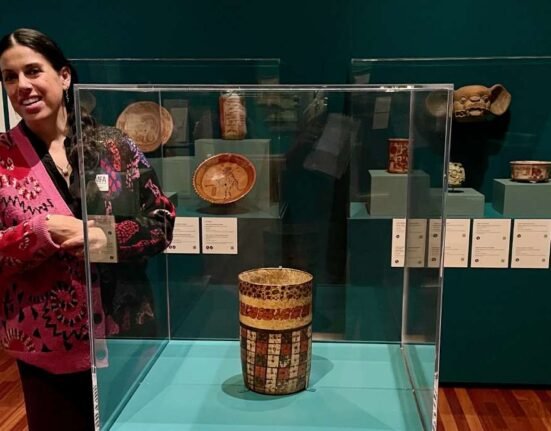The director of the Art Gallery of New South Wales (AGNSW) Michael Brand will leave the Sydney gallery in July 2025, after 13 years at the helm.
Brand’s departure follows the completion of the $344 million Sydney Modern project in December 2022, including the opening of a new building — called Naala Badu — and the restoration of the original 19th-century neoclassical building, renamed Naala Nura.
In a statement, Brand described his time at the helm of AGNSW as an “honour” and said he had been drawn to take on the role at AGNSW by the ambition of the Sydney Modern project.
“When we unveiled the Sydney Modern vision in 2013, I said it would be a green light for art, artists and audiences,” he said.
When the new building opened, then-premier Dominic Perrottet described the project as “most significant cultural build” since the Sydney Opera House. (Supplied: AGNSW/Iwan Baan)
“My decision to step down next year follows much reflection. As we are now building on the success of the Sydney Modern transformation, it feels like the right time to transition to a new generation of leadership for the next exciting chapter in the history of our 153-year-old art museum.”
The project saw the gallery almost double in size and more than 2 million people visit in its first year, becoming one of the world’s top 30 most-visited art museums (it currently sits at #28, four spots ahead of Melbourne’s National Gallery of Victoria).
It also represented an enormous philanthropic effort from Brand and president of the gallery’s board of trustees David Gonski, who together raised more than $110 million for the project from private donors.
Gonski, whose term as president ends in December, described Brand’s contribution to the gallery as “immense”: “We are indebted to his ambition and vision to create a globally significant art museum in Sydney.”
Sri Lankan Australian artist Ramesh Mario Nithiyendran — who has been exhibited and collected by the gallery, and will host ABC RN’s The Art Show in November — describes Brand as “artist-focused and artwork-focused”.
“What people forget is that when you’re working for an institution with such a large scale [like AGNSW], it’s always about the art,” he tells ABC Arts.
Ramesh Mario Nithiyendran was a finalist in both the Archibald and the Sulman prizes at AGNSW in 2019. (Supplied: Mark Pokorny)
“With Michael, you could tell that what excited him the most was seeing the artworks installed, seeing these amazing installations come to life, and seeing communities interacting with artworks.”
Brand — a scholar of Indian and Islamic art, architecture and landscape design — started his career as curator of Asian art at Canberra’s National Gallery of Australia. He later took up directorships at galleries overseas, including the J. Paul Getty Museum in Los Angeles and the Virginia Museum of Fine Arts, and returned to Australia in June 2012 to lead AGNSW, joining the gallery from the Aga Khan Museum in Toronto.
He became only the ninth AGNSW director since 1892, following the retirement of art scholar Edmund Capon, who led the gallery for 33 years. Brand has not indicated what his next career move will be.
Potential successors include AGNSW’s deputy director Maud Page, Art Gallery of South Australia’s former assistant director Lisa Slade, and Australian art historian Suhanya Raffel, director of M+ museum in Hong Kong. If successful, they would become the first woman to lead the gallery.
Championing diverse art and artists
Brand has been director as the gallery has acquired a wide range of works, including art by Yolŋu artists from Yirrkala, paintings from the Spanish Golden Age, and contemporary South Asian Art.
He has also led the gallery as it set up dedicated space for exhibitions from emerging and mid-career Australian artists.
In 2020, when the gallery reopened after a COVID-19-induced shutdown, Nithiyendran’s installation Avatar Towers loomed at the entrance: a 5-metre-tall sculpture made up of more than 70 grinning ceramic and bronze figures on a wooden structure.
Nithiyendran’s Avatar Towers was also exhibited in AGNSW’s new building as part of the exhibition Dreamhome: stories of art and shelter. (Supplied: AGNSW/Diana Panuccio)
“I was really young,” says Nithiyendran. “I’d never really exhibited at the gallery prior.
“Growing up, I didn’t really go to any cultural institutions. They always seemed a bit out of reach. Having a work placed [in a gallery] at the start [of my career] — [a work] that was kind of an ode to multiculturalism — was really important to me.”
For Filipina Australian artist Marikit Santiago — the winner of the 2024 La Prairie Art Award from the AGNSW and the 2020 winner of the Sulman Prize — what stands out for her about Brand’s time at the gallery is the way he created a welcoming environment.
Marikit Santiago with her family and AGNSW director Michael Brand after she won the Sulman Prize in 2020 for her painting The Divine. (Supplied: Coby Edgar)
“Galleries are not this elitist, snooty place that you need to be well-educated to enter,” says Santiago.
“I think the gallery under Michael’s direction has really led that ‘art for all’ ethos. I can feel that as a mum walking through the gallery with three little kids.”
Brand has also been supportive of her career. He attended the opening of her 2023 exhibition at Fairfield City Museum & Gallery, where he introduced himself to her family, wrote her a letter of support for a successful grant application, and recently facilitated her access to the gallery’s collection to create new work for an upcoming exhibition at the Campbelltown Arts Centre.
And both of Santiago’s winning works have been acquired by the gallery.
“Being an artist, there are always those moments of doubt,” she says. “To be backed by the Art Gallery of New South Wales is huge and it drives me to continue and to keep making.
Marikit Santiago won the acquisitive La Prairie Art Award for an Australian woman artist in March for her portraits of her family. (Pictured: A Seat at the Table (Magulang)) (Supplied: AGNSW/Diana Panuccio)
“I feel like the things that I’m trying to say in my work about my multiple identities — of being a woman artist and a woman of colour and the daughter of migrants and living in Western Sydney — I feel like the Art Gallery is hearing all of those things.
“[And] not just in my work, but in the work of my peers as well, and really helping to have all of these communities have their voices represented and heard.”
That dedication to representing diverse communities also encourages a wider audience to come through the gallery.
“I think there’s a basic power of representation,” says Nithiyendran. “If people feel reflected in the artwork that’s on the walls, in the artists that are represented, that automatically increases numbers.
“But the other thing that I’ve noticed is that any audience is excited by encountering diversities of perspectives. Just having multiplicity and plurality brings in more people.”







